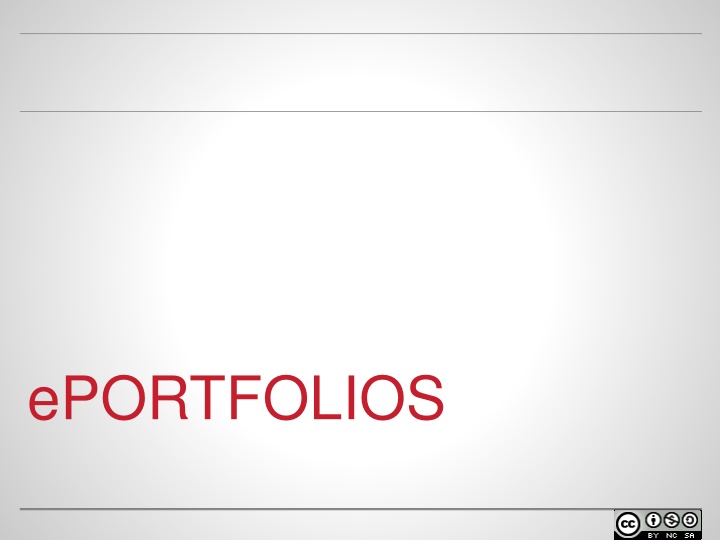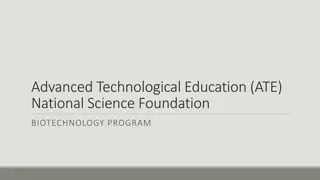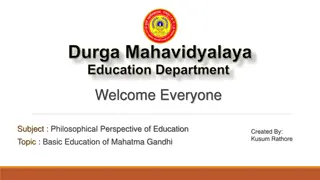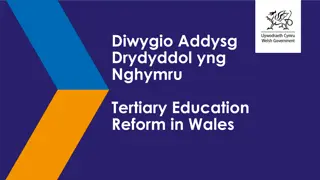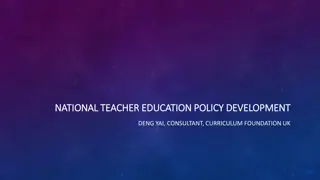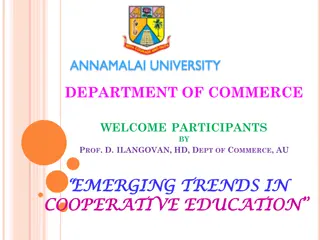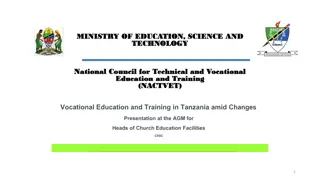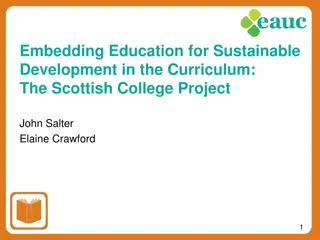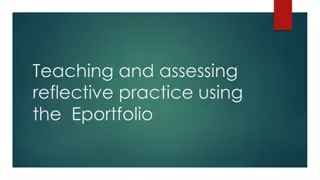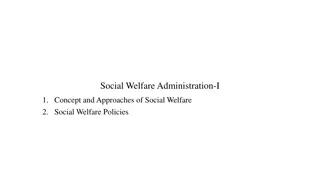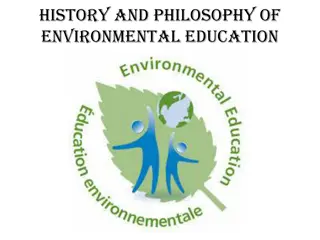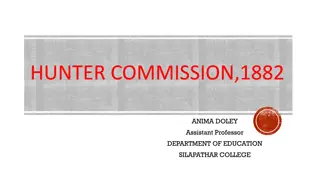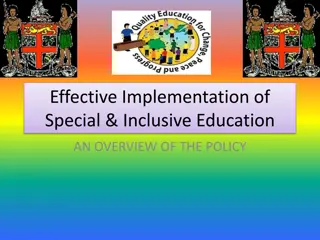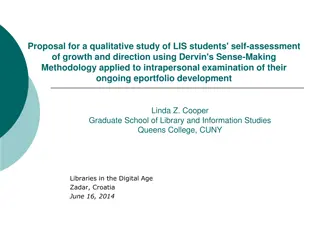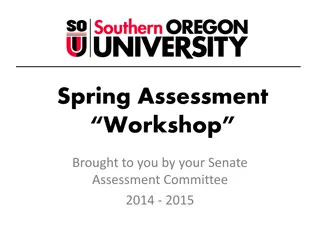ePortfolios in Education
In this module, discover the purpose, benefits, and best practices of using ePortfolios in education. Learn about different types of portfolios, the difference between ePortfolios and traditional ones, and how to develop an ePortfolio assignment. Dive into the world of digital artifacts and reflections to showcase learning and development.
Download Presentation

Please find below an Image/Link to download the presentation.
The content on the website is provided AS IS for your information and personal use only. It may not be sold, licensed, or shared on other websites without obtaining consent from the author.If you encounter any issues during the download, it is possible that the publisher has removed the file from their server.
You are allowed to download the files provided on this website for personal or commercial use, subject to the condition that they are used lawfully. All files are the property of their respective owners.
The content on the website is provided AS IS for your information and personal use only. It may not be sold, licensed, or shared on other websites without obtaining consent from the author.
E N D
Presentation Transcript
WELCOME o Facilitator name Position at university Contact info
LEARNING OUTCOMES By the end of this module, you should be able to: o describe the purpose and uses of ePortfolios; o identify the benefits and challenges of using ePortfolios for students and instructors; o describe best practices for using ePortfolios in your course; o develop an outline for an ePortfolio assignment, including assessment criteria.
AGENDA o What are ePortfolios? o ePortfolios in Teaching and Learning o Integrating ePortfolios
QUESTION o What are portfolios ?
WHAT IS A PORTFOLIO? Online Etymology Dictionary: o Etymology: Italian portafoglio "a case for carrying loose papers" Merriam-Webster: o a flat case for carrying documents or drawings o a set of drawings, paintings, or photographs that are presented together in a folder
WHAT IS A PORTFOLIO? o A collection of materials or work that demonstrate a person s skills, abilities or interests o May be paper-based or digital
PORTFOLIOS IN EDUCATION o A portfolio is a purposeful collection of student work that exhibits the student's efforts, progress, and achievements in one or more areas. (Paulson, Paulson and Meyer, 1991)
QUESTION o What are ePortfolios ? o What is the difference between an ePortfolio and a traditional paper portfolio?
ePORTFOLIOS o A purposeful collection of digital artifacts and reflections that provide evidence of learning and development ePortfolio
WHY ePORTFOLIOS? o Easy to share o Showcase multimedia (videos, etc.) o Easy to update o Difficult to lose or damage o Facilitate feedback, comment, collaboration
ePORTFOLIOS IN TEACHING AND LEARNING
GROUP DISCUSSION o How can ePortfolios be used effectively in higher education?
ePORTFOLIOS IN EDUCATION o Used at the course or program level o Demonstrate learning (knowledge, skills, abilities, values) o Assess student progress in achieving course/program level learning outcomes o Promote reflective thinking o Support learner-centred education
ePORTFOLIOS Video o ePortfolios in Higher Education
FOLIO THINKING o Reflective practice that aims to encourage students to integrate discrete learning experiences, enhance their self-understanding, promote taking responsibility for their own learning, and support them in developing an intellectual identity - (Penny-Light, Chen, and Ittleson, 2012)
PRODUCT AND PROCESS o ePortfolios are a combination of process (a series of activities) and product (the end result of the ePortfolio process) . - (Barrett, 2010)
PRODUCT AND PROCESS Product Process o Showcase (artifacts) o Reflecting on the learning experience (metacognitive thinking) o Online representation of students work o End-result of the process o Integrating learning
PRODUCT AND PROCESS The real value of an e-portfolio is in the reflection and learning that is documented therein, not just the collection of work. - (Barrett, 2010)
TYPES OF EPORTFOLIOS o Learning ePortfolio o Assessment ePortfolio o Showcase ePortfolio
LEARNING ePORTFOLIO o Reflective or process ePortfolio o Primary purpose is for learning and reflection o Course or program level o Support metacognitive development Example
ASSESSMENT ePORTFOLIO o Student assessment: Showcases work Capstone or graduation requirement o Program-level assessment: Used as evidence to show that students are meeting the program-level outcomes Example
SH0WCASE ePORTFOLIO o Audience is external o Final, finished product o Showcases the best work o Demonstrate skills/abilities/ achievements o In-depth resume/job application/ school application Example 1 Example 2
TYPES OF EPORTFOLIOS Learning Integrative Showcase Assessment
EMPLOYMENT PREPARATION Video o ePortfolios and Employment Preparation
ACTIVITY: ePORTFOLIO ASSIGNMENT Write a brief overview/description of your ePortfolio assignment for your chosen course. Your description should address the following questions: o How does this ePortfolio assignment support assessment of course learning outcomes? o What is the purpose of this ePortfolio assignment? o What transferable/transversal skills does the assignment ask students to demonstrate/develop?
GROUP DISCUSSION o How can we promote collaborative learning with ePortfolio assignments? o Is there opportunity for group folio thinking ?
COLLABORATIVE ePORTFOLIOS o A Metacognitive Approach to Mapping Collaborative Inquiry through E-Portfolios - (Takayama, 2014)
ePORTFOLIO BUILDING FRAMEWORK Collect Select Reflect Connect
ePORTFOLIO BUILDING FRAMEWORK Collect: o Work (essays, presentations, videos, graphics, music, etc.)
ePORTFOLIO BUILDING FRAMEWORK Select: o Pause and review collected work o Select key artifacts that best demonstrate learning and development o Depends on the purpose of the ePortfolio (e.g. learning? career/showcase?)
ePORTFOLIO BUILDING FRAMEWORK Reflect: o Heart of the ePortfolio building process o Takes place at several stages: When artifact is collected When artifact is selected When setting a direction for future learning goals
ePORTFOLIO BUILDING FRAMEWORK Connect: o Integrative learning: How does this relate to other experiences (academic, professional, co-curricular, personal)?
ePORTFOLIO PLATFORMS o Mahara o WordPress o Google Sites o Wiki o Domain of One s Own o PebblePad o Learning management systems: Brightspace/D2L Canvas Blackboard
GROUP DISCUSSION o Why are you considering integrating an ePortfolio assignment into your course? o What benefits do you think using ePortfolios has for you and your students?
BENEFITS FOR STUDENTS o Metacognition o Integrative learning o Deeper learning o Transferable & transversal skills o Articulate skills o Find employment o Technology and multi-media skills
BENEFITS FOR INSTRUCTORS o Review/revise course design o Support assessment of learning outcomes o Assess effectiveness of curriculum o See student progress/struggles o Measure student achievement of learning outcomes o Build relationships with students o Develop new technology skills and pedagogical approaches
ACTIVITY: THINK, INK, PAIR, SHARE o List your top three challenges (for you or students) Share these three challenges with your neighbour Choose three challenges; for each challenge, come up with one strategy for overcoming this challenge
BENEFITS AND CHALLENGES Video o ePortfolio Benefits and Challenges
REFLECTION o Central to ePortfolio pedagogy o Promotes metacognitive thinking o Helps students to make connections across diverse learning experiences o Supports awareness of growth and development as a learner
GROUP DISCUSSION o What are some strategies for supporting reflective thinking in students?
SUPPORT REFLECTIVE THINKING o Have a clear idea of what you want students to reflect on and why o Provide a model of a good reflection o Introduce early on and provide regular feedback o Provide opportunity for practice o Use question prompts
USEFUL QUESTION PROMPTS o Why did you choose this assignment for your portfolio? o What did you learn by creating this artifact? o What skills does this artifact showcase? How will you be able to apply these skills to other courses/contexts? o What are the connections between what we re doing in the classroom and other things you re doing?
COURSE-LEVEL ePORTFOLIO o Example: ePortfolio: Inspired Insights, Magnificent Failures, and Unanticipated Connections
ACTIVITY: ePORTFOLIO ASSIGNMENT o How will this ePortfolio assignment support reflective thinking in your students?
ASSESSING ePORTFOLIOS o Align with course learning outcomes o Develop a grading rubric Share with students to guide them Multiple graders can use to assess (TAs, students themselves, peers) o Provide opportunity for self and peer assessment
ASSESSING ePORTFOLIOS Build in multiple opportunities for formative feedback: students are more likely to engage in deep, integrative learning when faculty and other students look at the portfolio and comment on them. - Catalyst for Learning: ePortfolio Resources and Research
